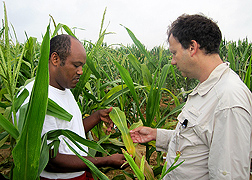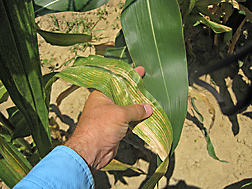Want To Know What a Gene Does?
Use a Little MAGIC
|
|
Do you believe in MAGIC? Agricultural Research Service plant geneticist Peter Balint-Kurti and colleagues at Purdue University do, especially when it comes to testing gene function in maize plants. But these scientists aren’t using card tricks or pulling rabbits out of hats. For them, MAGIC is an acronym that stands for “mutant-assisted gene identification and characterization.”
“MAGIC is a gene-centered approach that uses mutant genes or other genetic variants controlling a trait of interest as ‘reporters’ to identify novel genes and variants for that trait,” explains Balint-Kurti, who is in the ARS Plant Science Research Unit in Raleigh, North Carolina. He teamed up with Guri Johal and Cliff Weil at Purdue to create MAGIC.
MAGIC offers researchers a new way of sifting through the large amount of natural genetic variation present in most plant species to identify and map versions of genes important for the control of specific agriculturally useful traits. MAGIC starts out with a clearly defined mutation affecting a trait of interest and then identifies other genomic regions that affect the same trait. By using a mutation, the trait in question can be exaggerated, making it easier to spot other genes affecting the trait that would not otherwise be readily detectable. The process involves crossing the mutant gene into plants with different genetic backgrounds and then evaluating the offspring for the strength of the mutant phenotype.
Balint-Kurti and colleagues demonstrated MAGIC’s usefulness when examining “hypersensitive response” in maize. Hypersensitive response is a defense mechanism used by all plants in which one or a few cells surrounding the site of pathogen attack essentially commit suicide to prevent further spread of the pathogen.
In a study published in Genetics, the researchers reported on mutant gene Rp1-D21, a partially dominant disease-resistance gene that causes hypersensitive-response lesions to form spontaneously all over the plant—whether the pathogen is present or not. They found that the gene’s phenotype is profoundly affected by genetic background. The scientists crossed a plant containing Rp1-D21 with offspring of B73 and Mo17, two popular maize inbred lines. B73 partially suppresses the Rp1-D21 phenotype, and Mo17 partially enhances it. With this approach, the scientists identified a genomic location involved in the pathway controlling the start or local spread of hypersensitive response.
“By using the MAGIC technique, breeders can effectively screen the vast amount of genetic diversity present in maize—and in other plant species—for lines and genomic locations that have genes useful for controlling important plant traits, such as drought tolerance, sugar accumulation, and aluminum tolerance,” says Balint-Kurti. “In the present study, we are identifying variation controlling the plant defense response, which has been essentially invisible to us until now. This brings us one step closer to producing disease-tolerant cultivars.”
More hypersensitive-response studies are under way. Funded by the National Science Foundation, the scientists are now using MAGIC to screen the 5,000-line Nested Association Mapping population—recently established by ARS scientists—for other genomic regions responsible for hypersensitive response. (See “Opening Up a New World of Maize Traits” in this issue.)—By Stephanie Yao, Agricultural Research Service Information Staff.
This research is part of Plant Genetic Resources, Genomics, and Genetic Improvement, an ARS national program (#301) described at www.nps.ars.usda.gov.
Peter Balint-Kurti is in the USDA-ARS Plant Science Research Unit, North Carolina State University, Gardner Hall, Room 3418, Box 7616, Raleigh, NC 27695; (919) 515-3516, peter.balint-kurti@ars.usda.gov.
"Want To Know What a Gene Does? Use a Little MAGIC" was published in the September 2010 issue of Agricultural Research magazine.








